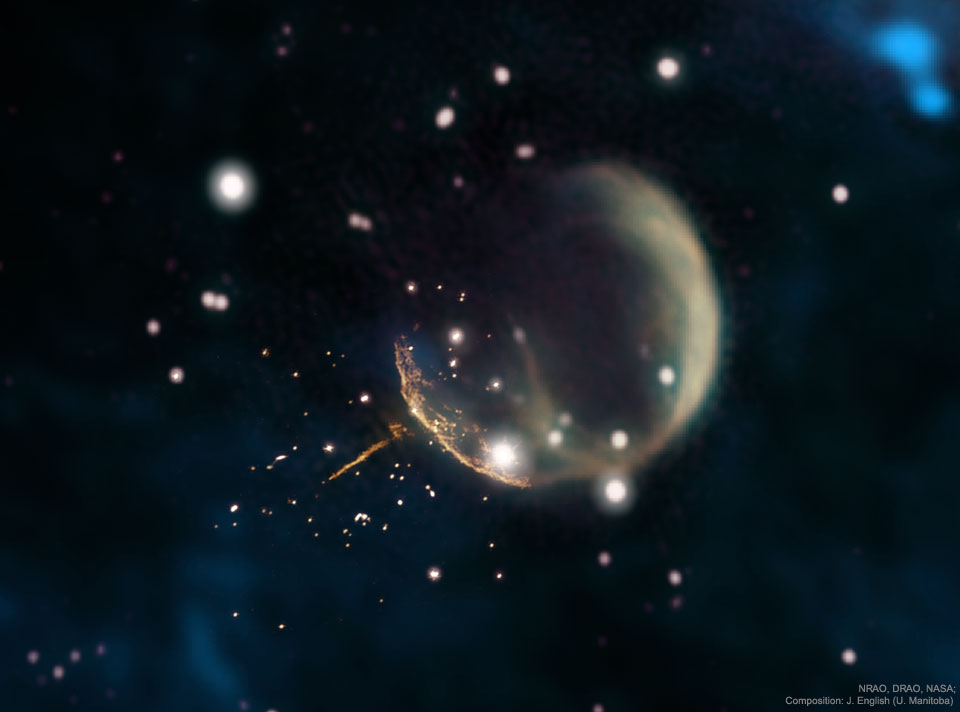02. October 2022
超新星炮台 kā 脈動星 J0002 搩出去

探索宇宙1!逐工會揀一幅無仝款 ê 影像抑是相片,𤆬你熟似咱這个迷人 ê 宇宙,閣有專業天文學者2為你3解說4。
- 原始文章:Supernova Cannon Expels Pulsar J0002
- 影像來源:F. Schinzel et al. (NRAO, NSF), Canadian Galactic Plane Survey (DRAO), NASA (IRAS); 資料合成:Jayanne English (U. Manitoba)
- 台文翻譯:An-Li Tsai (NCU)
[漢羅] 超新星炮台 kā 脈動星 J0002 搩出去
是啥物物件會當 kā 中子星 當做炮彈按呢射出去? 是超新星啦! 差不多 1 萬年前,tī 銀河系內底 生出 超新星殘骸 CTB 1 ê 超新星,毋若毀滅一粒大質量恆星,而且 kā 新形成 ê 中子星 ê 核心,脈動星,炸掉矣。 這粒脈動星 一秒鐘踅 8.7 擺。 會揣著伊,是利用一款會當下載到家己電腦 ê 軟體 Einstein@Home,連到 踅地球--ê NASA Fermi Gamma-Ray 天文台 資料庫搜揣資料,才發現--ê。 這粒 脈動星 PSR J0002+6216 (簡稱 J0002) 一秒鐘行 1000 公里,早就已經脫離 超新星殘骸 CTB 1,而且伊 ê 速度緊甲 會當離開咱 ê 銀河系。 Tī 這張相片內底,咱會當看著 脈動星 ê 路線拖到超新星殘骸 ê 倒爿下跤遐。 這張影像 是 kā VLA kah DRAO 電波天文台 翕著 ê 電波影像,kah 踅地球 ê NASA IRAS 紅外線 天文台 ê 資料庫影像 鬥做伙,產生 ê 合成影像。 咱已經知影講超新星就敢若是炮台,咱嘛知影 脈動星就敢若是炮彈,毋閣咱猶毋知超新星是按怎 kā 脈動星搩出去--ê。
[POJ] Chhiau-sin-seng phàu-tâi kā Me̍h-tōng-chhiⁿ J0002 kiat--chhut-khì
Sī siáⁿ-mih mi̍h-kiāⁿ ē-tàng kā tiōng-chú-chhiⁿ tòng-chòe phàu-tôaⁿ án-ni siā--chhut-khì? Sī chhiau-sin-seng la̍h! Chha-put-to 1 bān nî-chêng, tī gîn-hô-hē lāi-té siⁿ-chhut chhiau-sin-seng chân-hâi CTB 1 ê chhiau-sin-seng, m̄-nā húi-bia̍t chi̍t-lia̍p tōa-chit-liōng hêng-chhiⁿ, jî-chhiáⁿ kā sin hêng-sêng ê tiōng-chú-chhiⁿ ê he̍k-sim, me̍h-tōng-chhiⁿ, chà tiāu--ah. Chit-lia̍p me̍h-tōng-chhiⁿ chi̍t bió-cheng se̍h 8.7 pái. Ē chhōe-tio̍h i, sī lī-iōng chi̍t-khoán ē-tàng hā-chài kàu ka-tī tiān-náu ê nńg-thé Einstein@Home, liân kàu se̍h tē-kiû--ê NASA Fermi Gamma-Ray thian-bûn-tâi ê chu-liāu-khò͘ chhiau-chhōe chu-liāu, chiah hoat-hiān--ê. Chit-lia̍p me̍h-tōng-chhiⁿ PSR J0002+6216 (kán-chheng J0002) chi̍t bió-cheng kiâⁿ 1000 kong-lí, chá to̍h í-keng thoat-lî chhiau-sin-seng chân-hâi CTB 1, jî-chhiáⁿ i ê sok-tō͘ kín kah ē-tàng lī-khui lán ê Gîn-hô-hē. Tī chit-tiuⁿ siòng-phìⁿ lāi-té, lán ē-tàng khòaⁿ-tio̍h me̍h-tōng-chhiⁿ ê lō͘-sòaⁿ thoa kàu chhiau-sin-seng chân-hâi ê tò-pêng ē-kha hiah. Chit-tiuⁿ iáⁿ-siōng sī kā VLA kah DRAO tiān-pho thian-bûn-tâi hip-tio̍h ê tiān-pho iáⁿ-siōng, kah se̍h Tē-kiû ê NASA IRAS âng-gōa-sòaⁿ thian-bûn-tâi ê chu-liāu-khò͘ iáⁿ-siōng tàu chò-hóe, sán-seng ê ha̍p-sêng iáⁿ-siōng. Lán í-keng chai-iáⁿ kóng chhiau-sin-seng to̍h ká-ná sī phàu-tâi, lán mā chai-iáⁿ me̍h-tōng-chhiⁿ to̍h ká-ná sī phàu-tôaⁿ, m̄-koh lán iáu m̄-chai chhiau-sin-seng sī án-ná kā me̍h-tōng-chhiⁿ kiat--chhut-khì--ê.
[KIP] Tshiau-sin-sing phàu-tâi kā Me̍h-tōng-tshinn J0002 kiat--tshut-khì
Sī siánn-mih mi̍h-kiānn ē-tàng kā tiōng-tsú-tshinn tòng-tsuè phàu-tuânn án-ni siā--tshut-khì? Sī tshiau-sin-sing la̍h! Tsha-put-to 1 bān nî-tsîng, tī gîn-hô-hē lāi-té sinn-tshut tshiau-sin-sing tsân-hâi CTB 1 ê tshiau-sin-sing, m̄-nā huí-bia̍t tsi̍t-lia̍p tuā-tsit-liōng hîng-tshinn, jî-tshiánn kā sin hîng-sîng ê tiōng-tsú-tshinn ê hi̍k-sim, me̍h-tōng-tshinn, tsà tiāu--ah. Tsit-lia̍p me̍h-tōng-tshinn tsi̍t bió-tsing se̍h 8.7 pái. Ē tshuē-tio̍h i, sī lī-iōng tsi̍t-khuán ē-tàng hā-tsài kàu ka-tī tiān-náu ê nńg-thé Einstein@Home, liân kàu se̍h tē-kiû--ê NASA Fermi Gamma-Ray thian-bûn-tâi ê tsu-liāu-khòo tshiau-tshuē tsu-liāu, tsiah huat-hiān--ê. Tsit-lia̍p me̍h-tōng-tshinn PSR J0002+6216 (kán-tshing J0002) tsi̍t bió-tsing kiânn 1000 kong-lí, tsá to̍h í-king thuat-lî tshiau-sin-sing tsân-hâi CTB 1, jî-tshiánn i ê sok-tōo kín kah ē-tàng lī-khui lán ê Gîn-hô-hē. Tī tsit-tiunn siòng-phìnn lāi-té, lán ē-tàng khuànn-tio̍h me̍h-tōng-tshinn ê lōo-suànn thua kàu tshiau-sin-sing tsân-hâi ê tò-pîng ē-kha hiah. Tsit-tiunn iánn-siōng sī kā VLA kah DRAO tiān-pho thian-bûn-tâi hip-tio̍h ê tiān-pho iánn-siōng, kah se̍h Tē-kiû ê NASA IRAS âng-guā-suànn thian-bûn-tâi ê tsu-liāu-khòo iánn-siōng tàu tsò-hué, sán-sing ê ha̍p-sîng iánn-siōng. Lán í-king tsai-iánn kóng tshiau-sin-sing to̍h ká-ná sī phàu-tâi, lán mā tsai-iánn me̍h-tōng-tshinn to̍h ká-ná sī phàu-tuânn, m̄-koh lán iáu m̄-tsai tshiau-sin-sing sī án-ná kā me̍h-tōng-tshinn kiat--tshut-khì--ê.
[English] Supernova Cannon Expels Pulsar J0002
What could shoot out a neutron star like a cannon ball? A supernova. About 10,000 years ago, the supernova that created the nebular remnant CTB 1 not only destroyed a massive star but blasted its newly formed neutron star core -- a pulsar -- out into the Milky Way Galaxy. The pulsar, spinning 8.7 times a second, was discovered using downloadable software Einstein@Home searching through data taken by NASA's orbiting Fermi Gamma-Ray Observatory. Traveling over 1,000 kilometers per second, the pulsar PSR J0002+6216 (J0002 for short) has already left the supernova remnant CTB 1, and is even fast enough to leave our Galaxy. Pictured, the trail of the pulsar is visible extending to the lower left of the supernova remnant. The featured image is a combination of radio images from the VLA and DRAO radio observatories, as well as data archived from NASA's orbiting IRAS infrared observatory. It is well known that supernovas can act as cannons, and even that pulsars can act as cannonballs -- what is not known is how supernovas do it.
詞彙學習
| 漢羅 | POJ | KIP | 華語 | English |
|---|---|---|---|---|
| 超新星 | chhiau-sin-seng | tshiau-sin-sing | 超新星 | supernova |
| 脈動星 | me̍h-tōng-chhiⁿ | me̍h-tōng-tshinn | 脈動星 | pulsar |
| PSR J0002+6216 | PSR J khòng-khòng-khòng-jī ka lio̍k-jī-it-lio̍k | PSR J khòng-khòng-khòng-jī ka lio̍k-jī-it-lio̍k | PSR J0002+6216 | PSR J0002+6216 |
| CTB 1 | CTB one | CTB one | CTB 1 | CTB 1 |
| 超新星殘骸 | chhiau-sin-seng chân-hâi | tshiau-sin-sing tsân-hâi | 超新星殘骸 | supernova explosion |
| 中子星 | tiōng-chú-chhiⁿ | tiōng-tsú-tshinn | 中子星 | neutron star |